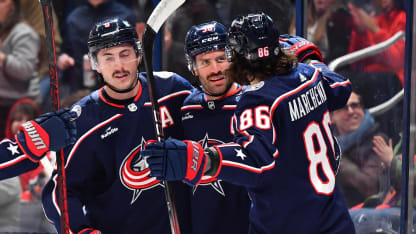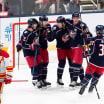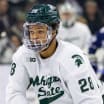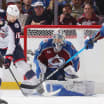Damon Severson has been through this before.
A mainstay with the New Jersey Devils before signing with the Blue Jackets in the offseason, he watched the team go through a rebuild that resulted in the drafting of No. 1 overall picks Nico Hischier (2017) and Jack Hughes (2019), not to mention such talented prospects-turned-NHLers as Luke Hughes and Jesper Bratt.
For years, fans in the Garden State wondered when adding those highly skilled players would lead to success on the ice, and it finally happened in 2022-23 when the Devils amassed 112 points and went to the second round of the playoffs in Severson’s final season with the squad.
While this year’s Devils team missed the playoffs during an injury-plagued campaign, they still boast one of the best young cores in the league and have a bright future. From his perspective, Severson saw what it takes for a young group to go from fresh-faced debutants to top-shelf NHLers leading a team to success, and he sees the same process unfolding in Columbus.
“The biggest thing is trying to take another step,” Severson said. “I saw it in New Jersey – the Hischiers, the Hughes, the Jesper Bratts. Some of these young players, you can see the talent, you can see the skills, you can see the work ethic. Everything is there. Now it’s a matter of taking that next step.
“We did last year, so now with the Columbus Blue Jackets here, we have to have those certain type of players as well to take the next step and carry us into the postseason.”
A return to playoff hockey for the first time since 2020 is on the mind of everyone in the CBJ organization, and getting there will require a marriage of the team’s culture-setting veterans and those highly touted recent draft picks.
Led by one of the top-rated prospect pools in the game – Columbus has made six first-round picks the last three years, with No. 4 overall on the way this summer – the Blue Jackets have a unique opportunity to build a sustained winner from the ground up over the coming seasons in the mold of a Boston, Tampa Bay or Colorado.
Much of the progress will happen naturally as players mature at the NHL level, and many of the struggles the past few years came because of the youth of the squad. Columbus entered the season with the third-youngest roster in the league with an average age of 25.8, and three of the 15 youngest players in the NHL were on the roster in Adam Fantilli, Cole Sillinger and David Jiricek.
By the time the season was over, the Blue Jackets had iced 11 players age 22 or younger as of Feb. 1, plus five more 23-year-olds, as compared to just six players age 30 or older. When competing against teams whose cores have been together for years like many of the league’s elite squads, winning games with such a young team is an uphill battle.
“It’s a game of men,” head coach Pascal Vincent said. “You look at the teams that are winning, you look at the history of the NHL in the past 10 years, the teams that are making the playoffs are not the youngest teams in the NHL. Being one of the youngest teams in the NHL is something you have to go through at some point in your cycle, but at some point you have to get older.
“It’s just the nature of the game in the NHL. The National Hockey League is the best league in the world, composed of the best players in the world, and men are winning in this league – for different reasons. Just physically, they’re stronger. They can sustain a certain pace for longer periods of time, for longer months.
“They know what it takes. They have this swagger and this confidence that when a game is 2-2, 3-2, 2-1, they know how to react. There’s the leadership part that comes with it. They have experience about, ‘OK, we’re going through a tough period, this is what we need to do. We’re going to get closer together,’ instead of being uncertain what is happening right now.”
Those things are coming with time and experience, and the current task for the Blue Jackets is making sure those young players are developed the right way. That’s where the team’s leadership council – captain Boone Jenner and alternates Zach Werenski, Sean Kuraly and Erik Gudbranson – plus fellow veterans like Severson, Johnny Gaudreau and others are working to make sure those youngsters have good role models.
There was certainly progress this year for such youngsters as Fantilli, Cole Sillinger, Yegor Chinakhov, Daniil Tarasov and others, one reason why CBJ veterans think a turnaround could on the way.
“In terms of where we’re at right now, I don’t really think we’re far off,” Werenski said. “I don’t think we’re as bad as our record showed this year or where we’re at in the standings. Obviously in saying that, the standings are the standings, wins are wins and losses are losses. We have a lot of work to do, but I think we have a lot of good pieces in there.
“We have a lot of talent. I don’t think talent is our issue by any means. It’s just that collective buy-in as a team. It starts with older guys making sure the young guys buy in and are playing for each other. It’s something if we do that, we’re gonna have some success.”
The young players on the squad feel good about how things have gone so far, and the hope is to build a close-knit unit that will have a lot to celebrate in the future.
“I think the closest teams win,” Fantilli said. “That’s what I’ve learned throughout my short amount of time playing with guys over 20 years old, but even at Michigan, we were always told the closest teams win, so trying to be as close as a team. Obviously we have a wide range of ages – guys who have kids and guys have a lot of other things going on in their lives – but when we’re on the road it’s really good to be around each other.”

















